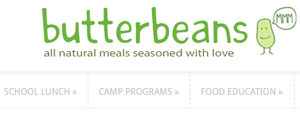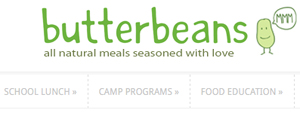
What kids eat at school is getting a lot more scrutiny these days.
Schools often (though not always) serve the cheapest, most heavily processed meals. Since the controversy about “pink slime” in the meat served in school lunches a few years ago, many parents have grown increasingly worried about school food quality.
 That’s the backdrop for Butter Beans, a New York City company that sells nutritious lunches to local schools and educates students on the value of good food. The company’s mission is “to provide healthy food for bodies and minds through our tasty, nutrient-rich lunches, and fact-filled wellness initiatives that address the alarming health statistics of children today.”
That’s the backdrop for Butter Beans, a New York City company that sells nutritious lunches to local schools and educates students on the value of good food. The company’s mission is “to provide healthy food for bodies and minds through our tasty, nutrient-rich lunches, and fact-filled wellness initiatives that address the alarming health statistics of children today.”
Foods all kids need (and don’t)
Flora McKay, director of community and nutrition at Butter Beans, encourages schools to make their meals with real foods made from natural ingredients. “Eating as close to nature as much as possible is the best recipe for success,” McKay says, “along with eating the colors of the rainbow to obtain the numerous nutrients intrinsic in different types of foods.” This diet should include fruits, vegetables, whole grains, healthier fats and well-sourced proteins, McKay says.
McKay further suggests that schools and parents alike follow basic food rules in feeding young people. She advises eating processed foods only if they have ingredients you can pronounce, and avoiding processed food products if they have more than five ingredients.
Why kids should grow, harvest and cook foods
While many students are familiar with foods as a product of boxes, Butter Beans focuses on the “seed-to-soil journey of food.” That means teaching students about the technical processes of growing and preparing food, and helping them understand seasonal foods and the nutritional and cultural aspects of food consumption. Ultimately, Butter Beans hopes that teaching food literacy to students will help them see how their food choices influence their health and the community and world they live in.
This kind of education gives students more than the technical skills they need to grow and prepare foods. McKay says young children will learn about “responsibility, decision making, cooperation, teamwork, patience, dedication, math and science exploration” as well.
The Butter Beans philosophy is that students who are closer to their foods will be more interested and engaged in the process of eating. Furthermore, growing, harvesting and cooking food will make them more likely to be interested in trying the literal fruits of their labor.
Promoting a nutrition-based education
Promoting healthier lifestyles and a better understanding of how to eat healthy starts at the lunch table, but schools that do this have to take a top-down approach. McKay says schools that do this successfully encourage “healthy eating through nutritious school meals, and see the cafeteria as a natural extension of the classroom. So much is learned in the cafeteria space, from patience to making food choices, open communication, manners, mindfulness and food waste. The cafeteria environment is a great experiential learning opportunity for children.”
Faculty and staff involvement is crucial for program success. McKay says teachers need to act as models for students by both encouraging them to try new foods and modeling healthy eating on their plates. McKay notes that when her company introduces a new or more adventurous food, they often pass out a 1-ounce serving to all students and encourage them to try it without pressure. Many students find this process encouraging, and often request a full serving of the new food being offered.
While nutritional knowledge can be achieved through schoolwide composting, gardening and cooking programs, schools and parents can do even more to foster this sort of education. McKay suggests that “There are various activities that parents and children can partake in that lead to a greater connection with food like: visiting the local farmers market, making a DIY compost bin, foraging for wild foods, visiting farms, growing a small garden, planting a seed and watching it grow, or regrowing food scraps.”
Regardless of the school’s ability to provide this curriculum, parents can encourage kids to participate in these processes on their own.
Caitrin Blake has a BA in English and Sociology from the University of Vermont and a master’s degree in English literature from the University of Colorado Denver. She teaches composition at Arapahoe Community College.
Categorized as: Current Events
Tagged as: Engaging Activities, Physical Education and Health, School Supplies
